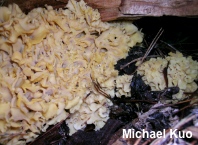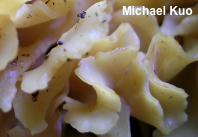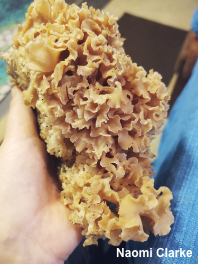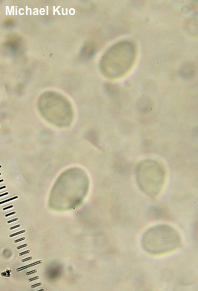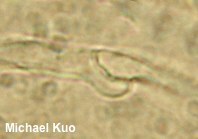| Major Groups > Clubs & Corals / Polypores > Sparassis > Sparassis radicata |

|
Sparassis radicata [ Basidiomycota > Polyporales > Sparassidaceae > Sparassis . . . ] by Michael Kuo Western North America's Sparassis radicata, like its eastern counterparts Sparassis americana and Sparassis spathulata, is found at the bases of trees, growing from dead or dying roots. But while the eastern species appear under both conifers and hardwoods, the western species is found only under conifers (especially Douglas-fir). The physical appearance of Sparassis radicata, which looks like a large clump of tightly packed egg-noodles, is pretty much unmistakeable. Sparassis radicata, as its Latin name suggests, usually has a radicating, underground portion—but the long, fleshy "root" is often overlooked when the mushroom is picked. "Sparassis crispa" in the sense of several western authors (e.g. Arora 1986, States 1990) is a synonym. This confusion results from the fact that Sparassis radicata was originally described (Weir, 1917) as a western, conifer-loving, rooting morphological species, but was later found to be the same biological species as European and Asian Sparassis crispa specimens in a mating study (Martin & Gilbertson 1976—using southwestern specimens). More recently, however, DNA evidence (e.g. Zhao et al. 2013, Hughes et al. 2014) supports the idea that Sparassis radicata is a distinct phylogenetic species limited to the Pacific Northwest and northern California. Thanks to Naomi Clarke for documenting, collecting, and preserving Sparassis radicata for study; her collection is deposited in The Herbarium of Michael Kuo. Description: Ecology: Pathogenic and saprobic; growing from the roots or bases of trees; found under conifers (especially pines and Douglas-fir); annual, but often recurring yearly in the same location; causing a brown rot or a butt rot; fall and winter; originally described from Idaho; distributed in the Pacific Northwest and northern California. The illustrated and described collections are from California and Oregon. Fruiting Body: 10–45 cm across; up to 30 cm high; composed of tightly packed, noodle-like branches which arise from a common basal structure (which measures up to 30 cm long, tapering into the ground); branches thin-fleshed, whitish to yellowish or tan, evenly colored, bald; flesh whitish, unchanging when sliced. Odor and Taste: Not distinctive. Spore Print: Whitish. Microscopic Features: Spores 4–7 x 2.5–4 µm; ellipsoid or broadly ellipsoid; smooth; hyaline in KOH; inamyloid. Basidia 40–55 x 5–6 µm; narrowly clavate; 4-sterigmate. Cystidia not found. Contextual hyphae 3–8 (–10) µm wide; smooth; walls to 0.5 µm thick; hyaline in KOH; clamp connections present. REFERENCES: J. R. Weir, 1917. (Smith, 1975; Martin & Gilbertson, 1976; Smith, Smith & Weber, 1981; Arora, 1986; Wang et al., 2004; Blanco-Dios et al., 2006; Dai et al., 2006; Trudell & Ammirati, 2009; Light & Woehrel, 2009; Ryoo et al., 2013; Zhao et al., 2013; Hughes et al., 2014; Desjardin, Wood & Stevens, 2015; Siegel & Schwarz, 2016.) Herb. Kuo 01170508, 11132001. This site contains no information about the edibility or toxicity of mushrooms. |
© MushroomExpert.Com |
|
Cite this page as: Kuo, M. (2021, June). Sparassis radicata. Retrieved from the MushroomExpert.Com Web site: http://www.mushroomexpert.com/sparassis_radicata.html |
